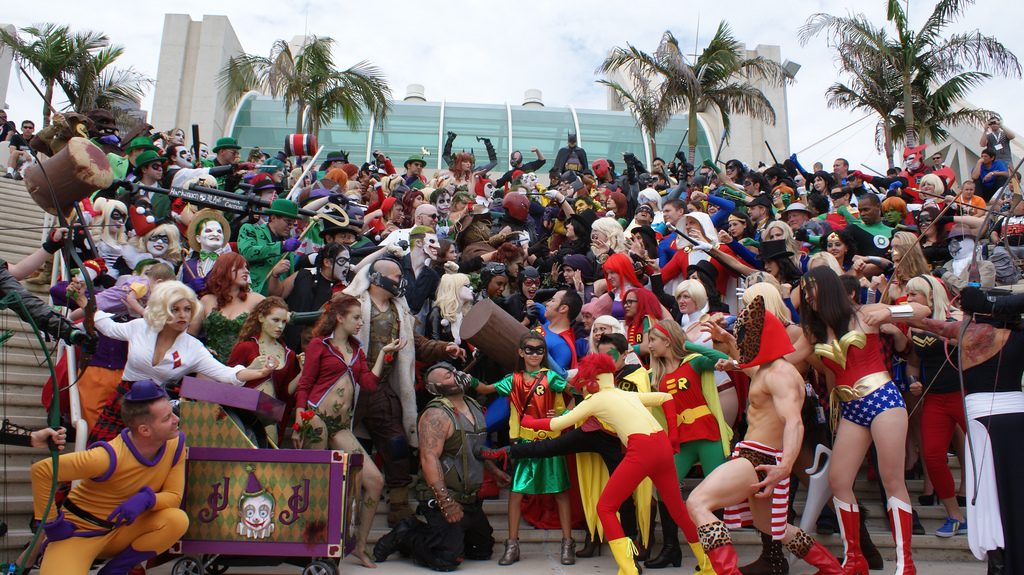Picture this: It’s July 2018, and I’m standing outside the San Diego Convention Center, badge in hand, heart pounding like I’d just outrun a horde of zombies from my favorite comic series. I’d dreamed about attending Comic-Con for years—visions of celebrity panels, epic cosplays, and endless stacks of graphic novels dancing in my head. But as the doors swung open and the crowd surged forward, reality hit like a plot twist in a thriller. The lines were endless, my feet ached after ten minutes, and I had no clue where to find the bathroom, let alone the Hall H panel I’d obsessed over. That first time was a whirlwind of excitement mixed with sheer chaos, but it taught me lessons I wish someone had shared upfront. Fast forward to now, after attending multiple cons including the massive San Diego Comic-Con (SDCC) in 2025, I’ve turned those mishaps into this guide. If you’re a first-timer staring down the barrel of your debut Comic-Con adventure, whether it’s SDCC or a local event like New York Comic Con (NYCC), this is your roadmap. We’ll cover everything from snagging tickets to surviving the crowds, with real tips drawn from my own blunders and triumphs. Trust me, with a little prep, you’ll transform from wide-eyed newbie to confident con-goer, ready to soak up the magic without the meltdowns.
What is Comic-Con?
Comic-Con, short for Comic Convention, started as a humble gathering of comic book fans in the 1970s but has exploded into a global pop culture phenomenon. Events like San Diego Comic-Con International draw over 135,000 attendees annually, blending comics, movies, TV shows, gaming, and more into one electric weekend. It’s not just about superheroes—think celebrity appearances, exclusive trailers, artist alleys, and fan meetups that celebrate creativity in all forms.
At its core, Comic-Con is a celebration of fandom where enthusiasts connect over shared passions. You’ll find panels discussing everything from Marvel’s latest phase to indie webcomics, alongside massive exhibit halls packed with merchandise and previews. For first-timers, it’s overwhelming yet exhilarating, like stepping into a live-action version of your favorite story—minus the script.
Planning Your Trip to Comic-Con
Diving into Comic-Con without a plan is like entering a boss fight unarmed—possible, but painful. Start months ahead by marking key dates, like SDCC’s badge sales which often sell out in hours. Research the specific con you’re attending, as each has unique vibes; SDCC is Hollywood-heavy, while smaller ones like Emerald City Comic Con feel more intimate.
Securing Your Badge
Badges are your golden ticket, and for big events like SDCC 2025 (held July 24-27), they’re notoriously hard to get. Register for the lottery system on the official site early—returning attendees get priority, but first-timers can snag spots during open registration. Prices range from $50 for a single day to $300 for a full weekend pass, including preview night.
Pro tip: Join online forums or follow @comic_con on X for real-time updates; I once missed a sale by minutes because I ignored notifications. If you strike out, check resale sites cautiously, but avoid scalpers to stay legit.
Booking Accommodations
Hotels near the venue book up fast and can cost $200-500 per night during peak con weekends. For SDCC, aim for downtown spots like the Hilton San Diego Bayfront or Marriott Marquis Marina for easy access— they’re steps from the action and often host after-parties. Book through official partners like onPeak to avoid scams.
If budget’s tight, consider Mission Valley options with shuttle service, saving you $100+ nightly. I learned the hard way my first time, crashing in a distant Airbnb and wasting hours commuting—lesson: proximity beats luxury every time.
Transportation Options
Flying into San Diego? The airport’s a quick trolley ride to the convention center, costing under $3. Driving? Parking is a nightmare—expect $30-50 daily fees and traffic jams. Rideshares like Uber surge during con hours, so budget extra or walk if you’re nearby.
Public transit shines here; SDCC offers free shuttles between hotels and the venue. For eco-friendly folks, rent a bike or scooter—it’s fun and dodges crowds. Whatever you choose, download apps like Google Maps for real-time routes to avoid getting lost in the geeky gridlock.
What to Pack for Comic-Con
Packing smart turns potential disasters into smooth sailing. Focus on comfort and essentials, as you’ll be on your feet for 10+ hours daily. Layer clothes for varying indoor AC and outdoor heat, and don’t forget ID for badge pickup.
My go-to bag? A sturdy backpack with compartments for swag. I once forgot sunscreen and ended up redder than Deadpool’s suit—never again. Tailor your list to your plans, like extra batteries if you’re live-tweeting panels.
- Comfortable walking shoes: You’ll log 20,000 steps easily; break them in beforehand.
- Reusable water bottle: Stay hydrated; refill stations are everywhere to cut costs.
- Portable charger: Phones die fast from photos and apps; aim for 10,000mAh capacity.
- Snacks like granola bars: Lines for food are long; pack non-perishables.
- Light sweater or hoodie: Halls can get chilly despite the summer vibe.
- Poster tube or comic sleeves: Protect your buys from bends and crowds.
- Hand sanitizer and masks: Post-pandemic wisdom—germs lurk in high-fives.
- Cash and cards: Some vendors are cash-only; split your budget to avoid ATM fees.
- Cosplay repair kit: Safety pins, tape, and glue for quick fixes if dressing up.
- Convention schedule app: Like the official SDCC one for planning on the go.
Navigating the Convention Center
The venue can feel like a labyrinth, with halls labeled A through H and floors buzzing with activity. Grab a map at entry and note landmarks like the main lobby or exhibit hall entrance. For SDCC, the center spans 2.6 million square feet—plan routes to avoid backtracking.
Arrive early to beat crowds; preview night (Wednesday for SDCC) is less hectic for first looks. Use elevators sparingly—they’re slow; stairs keep you moving. Humor helps: I once circled the same booth thrice, laughing it off as “exploration mode.”
Attending Panels and Events
Panels are Comic-Con’s heartbeat, featuring stars like those from “Avatar: The Last Airbender” or “Percy Jackson” in 2025. Schedules drop two weeks out via the official app—prioritize and line up early for big ones like Hall H, which seats 6,500 but fills fast.
No reservations needed for most, but popular ones require camping in line overnight. Bring entertainment like a book or card game; I bonded with strangers over trivia during a three-hour wait. If you miss out, many stream live or post online later.
How to Get Into Hall H
Hall H is the holy grail for movie trailers and celeb sightings. Wristbands are distributed the night before—show up by 7 PM for next-day access. Pack blankets and snacks for the line; it’s a rite of passage.
Once inside, no saving seats—first come, first served. Etiquette matters: ask thoughtful questions during Q&A, not personal ones. My first Hall H? Mind-blowing, but exhausting—pace yourself.
Exploring Off-Site Events
Beyond the center, downtown transforms with free activations like immersive experiences or pop-up shops. No badge required for many, like Funko Fundays or IMDb boat parties. Check sites like sdccblog.com for listings.
These add variety; I discovered a hidden arcade setup once, playing retro games till midnight. They’re great for breaks from the main chaos.
Cosplay for Beginners
Cosplay—dressing as characters—is optional but iconic. For first-timers, start simple: thrift store finds or Amazon buys over elaborate builds. Comfort is key; test your outfit for a full day to avoid chafing or breakdowns.
Ask permission before photos, and respect boundaries—”Cosplay is not consent.” Join parades or contests for fun; my debut as a casual Spider-Man led to instant friends. If skipping, admire from afar—it’s inspiring.
Cosplay Tips and Tricks
Practice poses at home for photos; mirrors help. Carry a repair kit—hot glue saves capes. Hydrate extra; layers trap heat.
Group cosplays amplify fun; coordinate with friends. For pros, enter contests early via the app. Remember, all levels welcome—effort counts more than perfection.
The Exhibit Hall and Shopping
The exhibit hall is a shopper’s paradise, with booths from Marvel to indie artists selling exclusives. Set a budget—items range from $10 pins to $500 statues. Haggle politely at smaller stalls; I scored a discount on a rare comic once.
Enter early to snag limited editions; lines form for booths like Funko. Use a swag bag for hauls, but ship heavy items home to avoid lugging. It’s overwhelming, so prioritize—make a wishlist from previews.
Best Deals and Where to Find Them
Artist Alley shines for unique art under $50; chat with creators for stories. Major studios offer freebies like posters—grab ’em quick.
Avoid impulse buys; compare prices. External links like eBay for exclusives help post-con, but nothing beats the thrill of on-site finds.
Food and Dining Options
Con food is pricey and lines long—$15 burgers aren’t uncommon. Pack snacks to save, but explore Gaslamp Quarter for variety: tacos at Lolita’s or burgers at Hodad’s.
Food trucks outside offer quick bites; vegan options abound at places like Plant Power. Hydrate constantly—dehydration sneaks up. My tip: Eat off-peak, like early lunch at 11 AM.
Comic-Con Etiquette and Safety
Respect rules: No running, weapons checks for cosplay, and always ask before touching. Be mindful in crowds—apologize for bumps. Harassing anyone? Instant ban.
Stay safe: Buddy system in crowds, charge phones, know exits. Report issues to staff; cons have anti-harassment policies. Light humor: If lost, follow the cosplayers—they know shortcuts.
Budgeting for Comic-Con
Costs add up fast—plan for $500-1500 total, depending on travel. Break it down to avoid surprises; I underestimated merch my first time and regretted it.
| Category | Estimated Cost | Tips to Save |
|---|---|---|
| Badge | $50-300 | Buy early for deals |
| Hotel (3 nights) | $600-1500 | Share rooms or stay further out |
| Travel | $100-500 | Use public transit |
| Food | $150-300 | Pack lunches |
| Merch | $200-500 | Set limits per day |
| Misc (parking, etc.) | $100-200 | Walk or shuttle |
Pros of Attending: Unmatched excitement, networking, exclusives. Cons: Crowds, expense, fatigue. Compared to NYCC, SDCC is larger but hotter—pick based on location.
People Also Ask
What should I bring to Comic-Con for the first time?
Essentials include comfy shoes, water bottle, charger, and snacks. Don’t forget your badge and ID—plus a bag for swag. From my experience, blister pads saved my feet during endless walking.
How do I prepare for long lines at Comic-Con?
Pack entertainment like books or games, and snacks. For Hall H, camp early with friends—it’s social. Hydrate and wear layers; lines can shift from sun to shade quickly.
Is cosplay required at Comic-Con?
No, but it’s fun! About half attend in costume. Start simple if interested—focus on comfort. Admire others respectfully; photos make great memories.
What are fun things to do at Comic-Con besides panels?
Explore off-sites, artist alley, or fan meetups. Free activations like movie premieres or gaming demos add variety. I once stumbled into a trivia night—pure joy.
Where can I find the Comic-Con schedule?
Official apps or sites like comic-con.org release it weeks ahead. Customize via MySchedule for panels. Check daily for updates—surprises happen.
FAQ
How much does it cost to attend Comic-Con?
Expect $500-2000 total, including badge ($50-300), lodging, food, and merch. Budget wisely—exclusives tempt splurges. For details, visit Comic-Con badges page.
What are the best hotels near San Diego Comic-Con?
Top picks: Hilton Bayfront or Omni for proximity. Book early via official channels to snag rates under $400/night. Alternatives like Best Western save cash.
How can I get autographs at Comic-Con?
Lotteries or lines for celebs; smaller creators are approachable. Bring items to sign—fees apply for big names ($50+). Be polite; timing matters.
What if I can’t get a badge for SDCC?
Try smaller cons or wait for resales (legit ones). Virtual options exist too. Persistence pays—many first-timers succeed eventually.
Best tools for planning Comic-Con?
Apps like SCHED for schedules, SpotHero for parking, and sdccblog.com for tips. Portable chargers and comfy gear are must-haves for survival.
Wrapping up, Comic-Con isn’t just an event—it’s a community where misfits become heroes. My first time was messy, but the connections and memories? Priceless. Dive in with this guide, embrace the chaos, and who knows—you might leave with a story wilder than any comic. See you in the halls next year!



